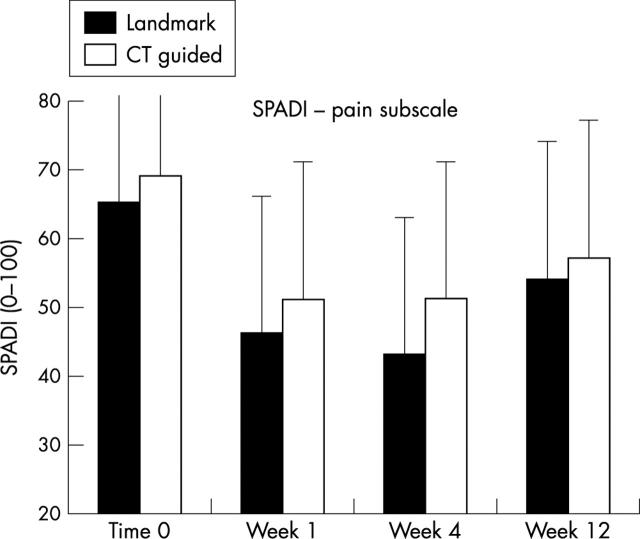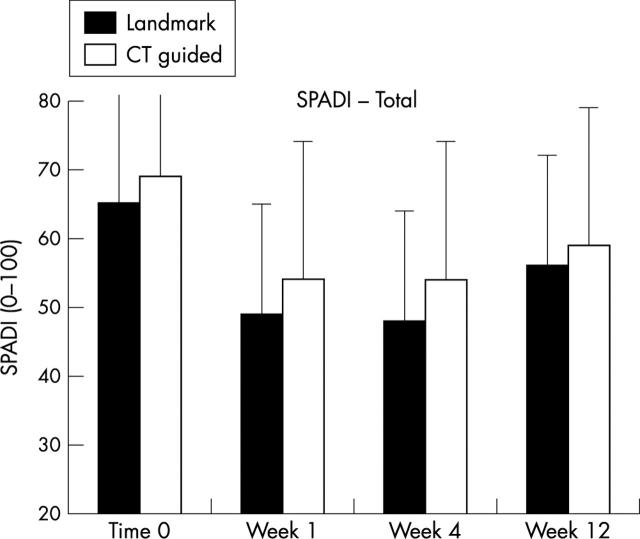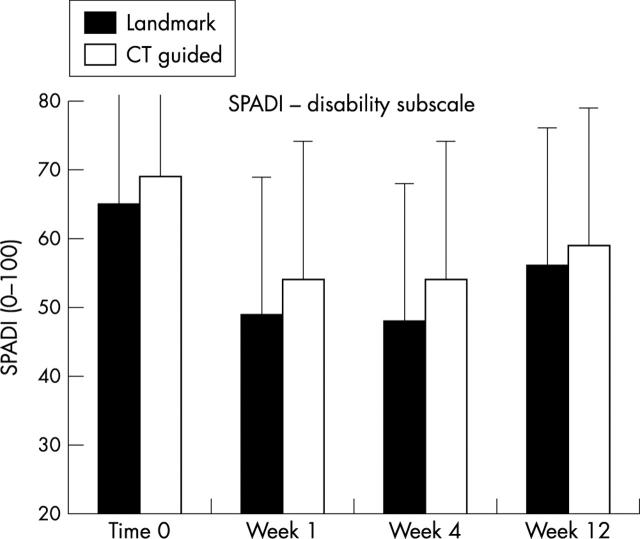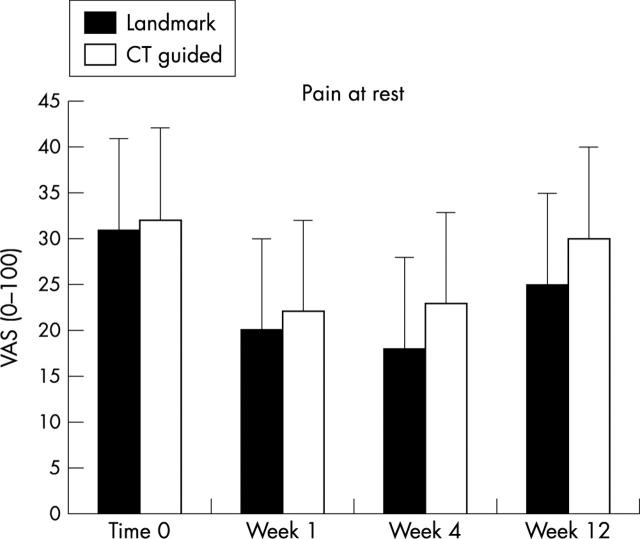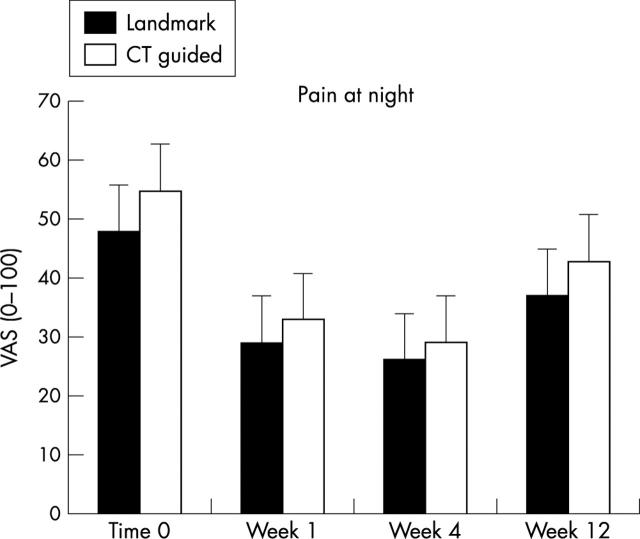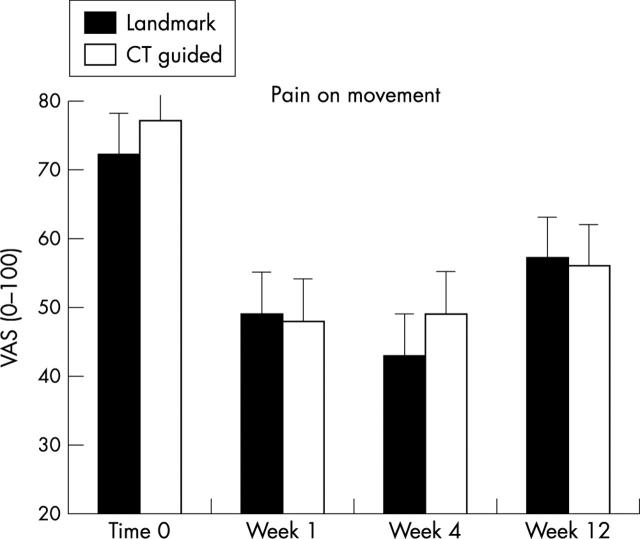Abstract
Background: Suprascapular nerve block is a safe and effective treatment for chronic shoulder pain in arthritis, which can be performed either by direct imaging (CT guided) or in the clinic using anatomical landmarks to determine needle placement.
Objective: To compare a CT guided versus an anatomical landmark approach in a randomised, single blind trial examining the efficacy of suprascapular nerve block for shoulder pain in patients with degenerative joint/rotator cuff disease.
Methods: 67 patients with chronic shoulder pain from degenerative disease participated in the trial. 77 shoulders were randomised. The group randomised to receive the block through the anatomical landmark approach received a single suprascapular nerve block. Those in the CT guided group received an injection of methylprednisolone acetate and a smaller volume of bupivacaine around the suprascapular nerve. The patients were followed up for 12 weeks by a "blinded" observer and reviewed at weeks 1, 4, and 12 after the injection.
Results: Significant improvements were seen in all pain scores and disability in the shoulders receiving both types of nerve block, with no significant differences in the improvement in pain and disability between the two approaches at any time. Improvements in pain and disability scores were clinically and statistically significant. No significant adverse effects occurred in either group. Patient satisfaction scores for pain relief using either approach were high.
Conclusion: The CT guided control and landmark approaches to performing suprascapular nerve blocks result in similar significant and prolonged pain and disability reductions; both approaches are safe.
Full Text
The Full Text of this article is available as a PDF (127.4 KB).
Figure 1.
SPADI (pain subscale) mean results. Error bars are standard deviations.
Figure 2.
SPADI (total subscale) mean results. Error bars are standard deviations.
Figure 3.
SPADI (disability) mean results. Error bars are standard deviations.
Figure 4.
Pain at rest (mean results). Error bars are standard deviations.
Figure 5.
Pain at night (mean results). Error bars are standard deviations.
Figure 6.
Pain on movement (mean results). Error bars are standard deviations.
Selected References
These references are in PubMed. This may not be the complete list of references from this article.
- Brown D. E., James D. C., Roy S. Pain relief by suprascapular nerve block in gleno-humeral arthritis. Scand J Rheumatol. 1988;17(5):411–415. doi: 10.3109/03009748809105280. [DOI] [PubMed] [Google Scholar]
- Dangoisse M. J., Wilson D. J., Glynn C. J. MRI and clinical study of an easy and safe technique of suprascapular nerve blockade. Acta Anaesthesiol Belg. 1994;45(2):49–54. [PubMed] [Google Scholar]
- Emery P., Bowman S., Wedderburn L., Grahame R. Suprascapular nerve block for chronic shoulder pain in rheumatoid arthritis. BMJ. 1989 Oct 28;299(6707):1079–1080. doi: 10.1136/bmj.299.6707.1079. [DOI] [PMC free article] [PubMed] [Google Scholar]
- Eustace J. A., Brophy D. P., Gibney R. P., Bresnihan B., FitzGerald O. Comparison of the accuracy of steroid placement with clinical outcome in patients with shoulder symptoms. Ann Rheum Dis. 1997 Jan;56(1):59–63. doi: 10.1136/ard.56.1.59. [DOI] [PMC free article] [PubMed] [Google Scholar]
- Huskisson E. C. Measurement of pain. J Rheumatol. 1982 Sep-Oct;9(5):768–769. [PubMed] [Google Scholar]
- Jones B., Jarvis P., Lewis J. A., Ebbutt A. F. Trials to assess equivalence: the importance of rigorous methods. BMJ. 1996 Jul 6;313(7048):36–39. doi: 10.1136/bmj.313.7048.36. [DOI] [PMC free article] [PubMed] [Google Scholar]
- Shanahan E. M., Ahern M., Smith M., Wetherall M., Bresnihan B., FitzGerald O. Suprascapular nerve block (using bupivacaine and methylprednisolone acetate) in chronic shoulder pain. Ann Rheum Dis. 2003 May;62(5):400–406. doi: 10.1136/ard.62.5.400. [DOI] [PMC free article] [PubMed] [Google Scholar]
- Vastamäki M., Göransson H. Suprascapular nerve entrapment. Clin Orthop Relat Res. 1993 Dec;(297):135–143. [PubMed] [Google Scholar]
- Vecchio P. C., Adebajo A. O., Hazleman B. L. Suprascapular nerve block for persistent rotator cuff lesions. J Rheumatol. 1993 Mar;20(3):453–455. [PubMed] [Google Scholar]
- Williams J. W., Jr, Holleman D. R., Jr, Simel D. L. Measuring shoulder function with the Shoulder Pain and Disability Index. J Rheumatol. 1995 Apr;22(4):727–732. [PubMed] [Google Scholar]



